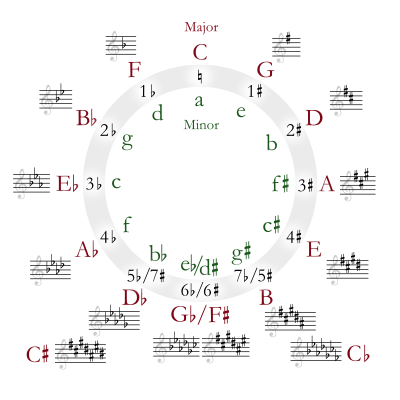Major scale: Difference between revisions
Jerome Kohl (talk | contribs) m Reverted edits by 72.73.162.135 (talk) to last version by Paolo.dL |
|||
| Line 57: | Line 57: | ||
* Jones, George Thaddeus. 1974. ''Music Theory: The Fundamental Concepts of Tonal Music Including Notation, Terminology, and Harmony''. Barnes & Noble Outline Series 137. [[New York City|New York]], Hagerstown, San Francisco, London: [[Barnes & Noble]]. ISBN 978-0-06-40137-4 |
* Jones, George Thaddeus. 1974. ''Music Theory: The Fundamental Concepts of Tonal Music Including Notation, Terminology, and Harmony''. Barnes & Noble Outline Series 137. [[New York City|New York]], Hagerstown, San Francisco, London: [[Barnes & Noble]]. ISBN 978-0-06-40137-4 |
||
* Kennedy, Michael. 1994. "Key-Signature". ''Oxford Dictionary of Music'', second edition, associate editor, Joyce Bourne. Oxford and New York: Oxford University Press. ISBN 0198691629. |
* Kennedy, Michael. 1994. "Key-Signature". ''Oxford Dictionary of Music'', second edition, associate editor, Joyce Bourne. Oxford and New York: Oxford University Press. ISBN 0198691629. |
||
*Yamaguchi, Masaya (New York: Charles Colin, 2000; Masaya Music, Revised 2006). The Complete Thesaurus of Musical Scales. ISBN 0967635306 |
|||
== External links == |
== External links == |
||
Revision as of 05:55, 15 December 2010

In music theory, the major scale or Ionian scale is one of the diatonic scales. It is made up of seven distinct notes, plus an eighth which duplicates the first an octave higher. In solfege these notes correspond to the syllables "Do, Re, Mi, Fa, Sol, La, Ti/Si, (Do)", the "Do" in the parenthesis at the end being the octave of the root. The simplest major scale to write or play on the piano is C major, the only major scale not to require sharps or flats, using only the white keys on the piano keyboard:
Structure

A major scale may be seen as two identical tetrachords separated by a whole tone, or whole step, the new set of steps "Whole:Whole:Half:Whole:Whole:Whole:Half"(in Semi-tone 2 2 1 2 2 2 1). Each tetrachord consists of two whole steps followed by a half step. Western scales do not skip any line or space on the staff, and they do not repeat any note with a different accidental. This has the effect of forcing the key signature to feature just sharps or just flats.
Named scale degrees
- 1st – Tonic- key note
- 2nd – Supertonic
- 3rd – Mediant
- 4th – Subdominant
- 5th – Dominant
- 6th – Submediant
- 7th – Leading tone
- 8th – Tonic ( or Octave)
The circle of fifths
The Circle of Fifths, first described in 1728 by Johann David Heinichen in his book Der General-bass, has been used ever since as a means of illustrating the relative harmonic distance between musical keys (Drabkin 2001).
The numbers inside the circle show the number of sharps or flats in the key signature, with the sharp keys going clockwise, and the flat keys counterclockwise from C major (which has no sharps or flats.) The circular arrangement depends on enharmonic relationships in the circle, usually reckoned at six sharps or flats for the major keys of F♯ = G♭ and D♯ = E♭ for minor keys (Drabkin 2001). Seven sharps or flats make major keys (C♯ major and C♭ major) that may be more conveniently spelled with five flats or sharps (as D♭ major or B major).
Harmonic properties
This section needs attention from an expert in Classical music. Please add a reason or a talk parameter to this template to explain the issue with the section. (November 2008) |
The major scale may predominate the minor scale in Western music because of its unique harmonic properties[citation needed] ; in particular the major third is much stronger in the harmonic series (it is the 5th, 10th and 20th harmonic – see below) than the minor third (the 19th harmonic).[citation needed]
In other words, the first six notes of the harmonic series provide a consonant major chord, the fourth to sixth of which form a major triad, and seven of the nine notes between the 8th and 16th harmonics (the 7th and 15th overtones) are notes in the major scale in just intonation.[citation needed] See the following:

The major scale allows:
- major or minor triads, both stable and consonant, on every scale degree but the seventh[vague]
- a diminished triad and a half-diminished seventh chord on the seventh degree, the leading tone.[vague]
- a dominant seventh chord on the fifth degree, the dominant[vague]
- motion by a minor second from the leading tone to the tonic[vague]
- root motion by perfect fifths, the strongest root motion, from nearly every degree in either direction, the two exceptions being up a diminished fifth from the seventh to the eleventh degree, and down a diminished fifth from the eleventh to the seventh.[vague]
See also
- Minor scale
- Enharmonic
- Equal temperament
- Just intonation
- Lydian mode
- Major and minor
- Music theory
- Tetrachord
References
- Bower, Michael. 2007. "All about Key Signatures". Modesto, CA: Capistrano School (K–12) website. (Accessed 17 March 2010)
- Drabkin, William. 2001. "Circle of Fifths". The New Grove Dictionary of Music and Musicians, second edition, edited by Stanley Sadie and John Tyrrell. London: Macmillan Publishers.
- Jones, George Thaddeus. 1974. Music Theory: The Fundamental Concepts of Tonal Music Including Notation, Terminology, and Harmony. Barnes & Noble Outline Series 137. New York, Hagerstown, San Francisco, London: Barnes & Noble. ISBN 978-0-06-40137-4
- Kennedy, Michael. 1994. "Key-Signature". Oxford Dictionary of Music, second edition, associate editor, Joyce Bourne. Oxford and New York: Oxford University Press. ISBN 0198691629.
- Yamaguchi, Masaya (New York: Charles Colin, 2000; Masaya Music, Revised 2006). The Complete Thesaurus of Musical Scales. ISBN 0967635306
External links
- Proper fingering of the major and minor scales on the piano
- Listen to and download harmonised Major scale piano MP3s
- The major and pentatonic scales on the guitar in several positions
- The major scale for guitar in one position, with derivation


